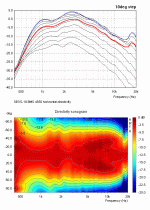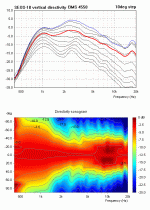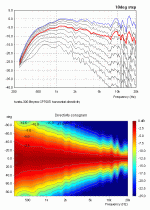From a non-techie, but still: I would add that pointing out a non-relation here says as little as pointing out the opposit; if there's no relation a good looking horn could just as well sound good as bad, so why the remark unless you're negatively biased?
Geddes has really nothing to gain and he has consistently been negative for years. Negative about everything that is not his own and he definitely has no chance in the style department. He actually thinks people buy for sceince over style
He sold wavegeuides that looked home made for $400
I think we hurt his feelings when saying these are the best looking waveguides
Last edited:
Have you ever considered thinking before being so negative?
For the links I suggest using a translator program. Jack's job isn't too spoonfeed you.
Good point. My bad! Sorry Jacek.
From a non-techie, but still: I would add that pointing out a non-relation here says as little as pointing out the opposit; if there's no relation a good looking horn could just as well sound good as bad, so why the remark unless you're negatively biased?
Again, correct, I should have keep this thought to myself.
Jacek - go ahead and sell the OS waveguide, I have no problem with that, I'm never going to do it.
My fault I haven't checked it. Try Rapidshare:
Isn't there some free way that I can download these files? I was able to get the .zip file, but not the .rar one.
Last edited:
Did you ever consider the fact that not everyone can read Polish? I have no idea what to do once I click on those links. You need a better method.
Put them on a website that you have access to and have them downloaded when clicked.
I have sent you this file (HolmImpulse zip archive with my 12"OSWG with/without foam) on the 8th of May.
M.
Last edited:
Hello,
The shape of the Iwata 300 is not chosen in order to look good.
It is simply the result of the effect of the oblate strain of the equidistant wavefronts ( = parallel wavefronts) the area of which follows an hypex law (T = 0.5 or 0.7) according to a linear variation -from throat to mouth- of the ratio between the curvilinear horizontal width and the curvilinear vertical height of the wavefronts (ratio variation from 1 to 4 from throat to mouth according to Iwata San for a medium frequency horn).
No additional hypothesis on the shape is used to calculate the horn.
It looks good and sounds good! (and no need for any bloody foam insert!)
Best regards from Paris, France
Jean-Michel Le Cléac'h
The shape of the Iwata 300 is not chosen in order to look good.
It is simply the result of the effect of the oblate strain of the equidistant wavefronts ( = parallel wavefronts) the area of which follows an hypex law (T = 0.5 or 0.7) according to a linear variation -from throat to mouth- of the ratio between the curvilinear horizontal width and the curvilinear vertical height of the wavefronts (ratio variation from 1 to 4 from throat to mouth according to Iwata San for a medium frequency horn).
No additional hypothesis on the shape is used to calculate the horn.
It looks good and sounds good! (and no need for any bloody foam insert!)
Best regards from Paris, France
Jean-Michel Le Cléac'h
What a shame that looking good and sounding good have no relationship to one another.
Oh, I think you may be overstating your position here. Looks do certainly factor into how most people perceive the sound of a loudspeaker. Behind a curtain as in your setup (as I understand it) obviously a non-issue, but with speakers in the living room, it's a biggie for your average person.
It looks good and sounds good! (and no need for any bloody foam insert!)
Keeping those inserts moist gets to be quite the pain, too!
I have sent you this file (HolmImpulse zip archive with my 12"OSWG with/without foam) on the 8th of May.
M.
So these are the same set of data? Its the SEOS that I am most interested in seeing.
Earl, did you get the SEOS curves I posted? (Do you need me to fill out the arrays for <500Hz and >20kHz in the frds?)
http://www.diyaudio.com/forums/group-buys/166312-waveguides-horns-63.html#post2612064
http://www.diyaudio.com/forums/group-buys/166312-waveguides-horns-63.html#post2612064
SEOS-18 horizontal directivity, 10deg step.
Shwing!
What driver is that with?
Also, do you have the outside dimensions of the waveguide (height, width)?
Driver was BMS 4550 - performance similar to DE250.
Height 8.35", width 18.3".
Attachments
Could you guys help me out for a minute. I see a disconnect between the measurements and the Directivity Sonogram on the SEOS-18 Horizontal plots. The color polars can't be from the posted data in the plots. If you look at the on axis response there is a peak at about 2.5K where it is +5 and at 10K it's 10db down, so we have a 15db spread.
That's not what is in the Directivity Sonogram. So what's up?? Is the Sonogram a plot of an equalized set-up with a crossover or is that from a different horn?? How much smoothing is used in the Sonograms??
Thanks Rob
That's not what is in the Directivity Sonogram. So what's up?? Is the Sonogram a plot of an equalized set-up with a crossover or is that from a different horn?? How much smoothing is used in the Sonograms??
Thanks Rob
Hello,
The shape of the Iwata 300 is not chosen in order to look good.
It is simply the result of the effect of the oblate strain of the equidistant wavefronts ( = parallel wavefronts) the area of which follows an hypex law (T = 0.5 or 0.7) according to a linear variation -from throat to mouth- of the ratio between the curvilinear horizontal width and the curvilinear vertical height of the wavefronts (ratio variation from 1 to 4 from throat to mouth according to Iwata San for a medium frequency horn).
No additional hypothesis on the shape is used to calculate the horn.
It looks good and sounds good! (and no need for any bloody foam insert!)
Best regards from Paris, France
Jean-Michel Le Cléac'h
Thanks!
I have 3 IWATAs now also 2 JBL CDs, 2 BMS 4590p CDs and just found some TAD TD-4001s that will be here this week..I should have some fun measurements and listening tests. Im curious to hear all the differences.
Also will compare the IWATA against the QSC HPR152i + BMS 4550 design.
Bass will be handled by JBL 2226s.
Oh, yeah they look very, very cool but I need to design a nice box to hold them because I do not like the look of open horns (I know, everyone is a little different
- Home
- Group Buys
- Waveguides and horns


